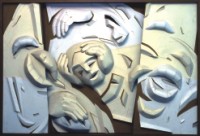Art

Ashna Ali
 |
Saidul Haque's untitled mask construction |
For all the sweat and blood artists pour into their work, the toil is often worth little if their intentions, skill and media don't come together to most effectively produce the desired effect. The importance of quality media is the focus of the current exhibition at The Bengal Gallery of Fine Arts in Dhanmondi, which opened on July 17. Sponsored by the eminent artist Monirul Islam, it featured the flexibility of Paper Studio's world-renowned line of paper newly arrived in Bangladesh, 'Conqueror.' Ten contemporary artists, prominent in their respective fields, were given their choice of 'Conqueror' paper and absolute creative freedom. The resulting work hangs together at the gallery to show the scope of artistic possibility offered by top of the line materials. Among the featured artists are photographers, painters, architects, a poet, a designer and a mask maker.
 |
Sajjad Sharif's "And then there was light" |
Upon entering the gallery, the viewer comes upon the starkest use of the paper in the collection. Poet Sajjad Sharif used rough white paper for three works where words and letters were used as visual tools in a modern graffiti style, leaning towards the graphic effect desired for political posters and other message-based graphic design. The piece "Political Monsoon" consists of thin irregular strips of newspaper apparently trickling down thick white paper like raindrops on a car window. "Correspondence" looks like a disturbing English classroom poster for adults where the relationship between the words "Art" and "Commune" are shown with cuts, arrows, dashes and equal signs between their respective prefixes and suffixes. The most striking of the three is "And Then There Was Light", a work where jumbled Bangla script printed in thick black print grows out of absolute darkness at the top of the paper, slowly becoming less congested and spread out as if in bloom until the very end of the paper, where the symbols reach their greatest point of clarity. If given the room it deserves, the piece seems to say, the written word can and will bring enlightenment from darkness.
Architect Salauddin Ahmed Patash also used symbols, this time on thick silver paper with a metallic sheen upon which obscure repeated symbols appeared in a regular code-like grid with the famous quotation attributed to multiple artists underneath, "Art is a lie which tells the truth." Space and regularity came into focus in his work, just as with the other featured architect, Marina Tabassum. A series of untitled works using the same kind of material have shapes punched into them like torn watermarks, the interruptions in the surface throwing the relationships between depth, space, texture and light into relief.
The same set of relationships are impressively explored in Saidul Haque Juise's work, where 'Conquerer' paper was used to construct faces and hands and wedges around them creating contours and contrasting with spaces left entirely empty, the negative space emphasising the works' refreshing three-dimensionality. The unconventional craft allowed for the paper to be not only an excellent surface for artistic work, but also a possible medium itself.
Across from the masks, the collection broke from the modern bent and showcased more conventional uses with the works of Hasan Saifuddin Chandan, whose black and white and colour photography was printed in the centre of high quality print paper, and Abir Abdullah whose large high contrast, glossy photographs showed children with bright red paper boats, planes and kites. The photographs introduced the flexibility allowed with colour on high quality surfaces, further explored on multiple kinds of paper by the featured painters and designers. Dhruba Esh, a designer known for exquisite book covers used the same metallic silver paper to create works where black and red hand prints hung next to splotches of light. Khaled Mahmud's work took advantage of metallic, seemingly translucent surfaces to create MTV-esque iconic images such as "Enchantment", where a photo of a man who looks vaguely like Jesus floats on a bed of stylised Arabic script and orange swirls, "Desire" and "Enigma" which manipulate the same techniques in a style that recalls Gnarles Barkley videos.
Painter Shishir Bhatterjee perpetuates the stark iconic quality of work with an untitled mixed media series where collections of objects and creatures both real and imagined come together, floating on the paper with their different mediums (apparently marker or ink, pastel and watercolor) giving them life through the texture and absorbency of the paper.
Last but most certainly not least, painter Ronni Ahmmed's work is featured where surrealist style takes full advantage of the apparent sheen and translucency of the paper. "Myth of Orthopedic Science" shows an enormous bulb flower growing underwater, as if bobbing, with a group of tiny houses settled at its root in a bed of seaweed. The background is painted in a startling, deep aquamarine and yet seems sheer and transparent like the water it represents. The same manipulation of paint and paper similarly emphasises the dream-like absurdism of the artist's work.
The exhibit's posters boast "It's in the paper", and while the quality and diversity of the paper is apparent, the gallery failed to provide other media information that may have deepened a viewer's understanding of the specific kinds of paper being used and the media used on it to understand the interaction between the two, along with, perhaps, more of the artists' intention and conceptual vision for their works. Despite this limitation, the sheer scope and diversity of the works in the gallery are worth absorbing, brought together by something as simple and often ignored as a well-produced sheet of paper.
 |
Abir Abdullah's photography (Left) and Ronni Ahmmed's Myth of Orthopedic Science(Right) |
Copyright (R) thedailystar.net 2007 |
